I am using OpenCV 4 and latest Python version. Got all the packages aswell.
I know how to resize, grayscale, blur, edge etc, but I get so many errors, seems like I cant get any detection.
Here is the Multimeter display image which is cropped which I am trying to detect and extract the digits from.
I need a simple code or help to code and to retrieve the digits, tried multiple guides without success. OpenCV is new to me, but took me 2-3 days to learn the basic image processing capabilities.
Digital multimeter non color

Ok, Now I have updated the code. I want to extract the digits from the warped and transformed binary image. But I get either errors or I need to delete parts of the code in order to at least show me the two images. Here is the code so far:
# import the necessary packages
from imutils.perspective import four_point_transform
from imutils import contours
import imutils
import cv2
# define the dictionary of digit segments so we can identify
# each digit on the thermostat
DIGITS_LOOKUP = {
(1, 1, 1, 0, 1, 1, 1): 0,
(0, 0, 1, 0, 0, 1, 0): 1,
(1, 0, 1, 1, 1, 1, 0): 2,
(1, 0, 1, 1, 0, 1, 1): 3,
(0, 1, 1, 1, 0, 1, 0): 4,
(1, 1, 0, 1, 0, 1, 1): 5,
(1, 1, 0, 1, 1, 1, 1): 6,
(1, 0, 1, 0, 0, 1, 0): 7,
(1, 1, 1, 1, 1, 1, 1): 8,
(1, 1, 1, 1, 0, 1, 1): 9}
# load the example image
image = cv2.imread("Multimeter_1.jpg")
# pre-process the image by converting it to
# graycale, blurring it, and computing an edge map
gray = cv2.cvtColor(image, cv2.COLOR_BGR2GRAY)
blur = cv2.GaussianBlur(gray, (7,7), 0)
thresh = cv2.adaptiveThreshold(blur,255,cv2.ADAPTIVE_THRESH_GAUSSIAN_C,
cv2.THRESH_BINARY_INV,87,9)
# find contours in the edge map,
cnts = cv2.findContours(thresh, cv2.RETR_EXTERNAL, cv2.CHAIN_APPROX_SIMPLE)
cnts = cnts[0] if len(cnts) == 2 else cnts[1]
cnts = sorted(cnts, key=cv2.contourArea, reverse=True)
rect = None
# loop over the contours
for c in cnts:
# approximate the contour
x,y,w,h = cv2.boundingRect(c)
#cv2.rectangle(image, (x, y), (x+w, y+h), (36, 255, 12), 1)
cv2.drawContours(image, [c], -1, (36,255,12),3)
rect = c
peri = cv2.arcLength(c, True)
approx = cv2.approxPolyDP(c, 0.02 * peri, True)
if len(approx) == 4:
rect = approx
break
# extract the display, apply a perspective transform
warped = four_point_transform(thresh, rect.reshape(4, 2))
output = four_point_transform(image, rect.reshape(4, 2))
# Warp the image and perform morphology to clean it
thresh = cv2.threshold(warped, 0, 255,cv2.THRESH_BINARY | cv2.THRESH_OTSU)
[1]
kernel = cv2.getStructuringElement(cv2.MORPH_ELLIPSE, (5, 5))
thresh = cv2.morphologyEx(thresh, cv2.MORPH_OPEN, kernel)
# pre-process the image by converting it to
# graycale, blurring it, and computing an edge map
gray = cv2.cvtColor(image, cv2.COLOR_BGR2GRAY)
blur = cv2.GaussianBlur(gray, (7,7), 0)
thresh = cv2.adaptiveThreshold(blur,255,cv2.ADAPTIVE_THRESH_GAUSSIAN_C,
cv2.THRESH_BINARY_INV,87,9)
# find contours in the edge map,
cnts = cv2.findContours(thresh, cv2.RETR_EXTERNAL, cv2.CHAIN_APPROX_SIMPLE)
cnts = cnts[0] if len(cnts) == 2 else cnts[1]
cnts = sorted(cnts, key=cv2.contourArea, reverse=True)
rect = None
# loop over the contours
for c in cnts:
# approximate the contour
x,y,w,h = cv2.boundingRect(c)
#cv2.rectangle(image, (x, y), (x+w, y+h), (36, 255, 12), 1)
cv2.drawContours(image, [c], -1, (36,255,12),3)
rect = c
peri = cv2.arcLength(c, True)
approx = cv2.approxPolyDP(c, 0.02 * peri, True)
if len(approx) == 4:
rect = approx
break
# extract the display, apply a perspective transform
warped = four_point_transform(thresh, rect.reshape(4, 2))
output = four_point_transform(image, rect.reshape(4, 2))
# Warp the image and perform morphology to clean it
thresh = cv2.threshold(warped, 0, 255,cv2.THRESH_BINARY | cv2.THRESH_OTSU)
[1]
kernel = cv2.getStructuringElement(cv2.MORPH_ELLIPSE, (1, 5))
thresh = cv2.morphologyEx(thresh, cv2.MORPH_OPEN, kernel)
cnts =
cv2.findContours(thresh.copy(),cv2.RETR_EXTERNAL,cv2.CHAIN_APPROX_SIMPLE)
cnts = imutils.grab_contours(cnts)
digitCnts = []
# loop over the digit area candidates
for c in cnts:
(x,y,w,h) = cv2.boundingRect(c)
# if the contour is sufficiently large, it must be a digit
if w >= 25 and (h >= 50 and h <= 60):
digitCnts.append(c)
cv2.imshow("Multimeter", image)
cv2.imshow("Multimeter2", thresh)
cv2.waitKey(0)
cv2.destroyAllWindows()
